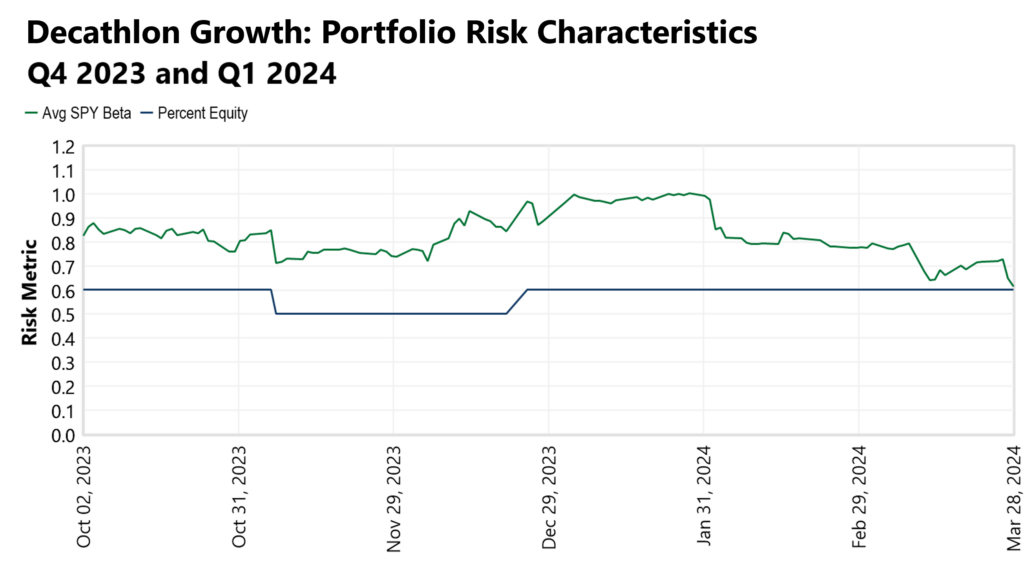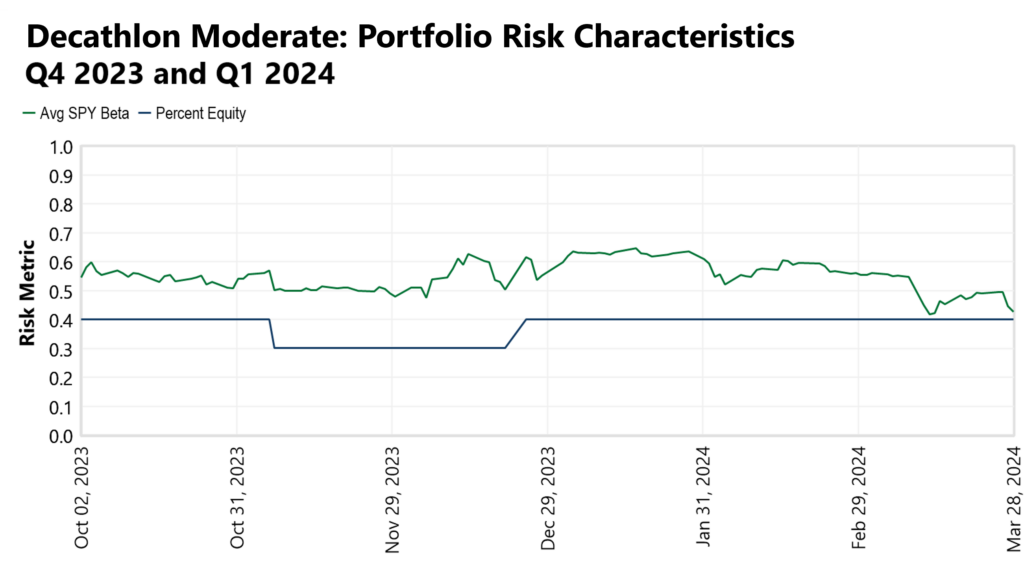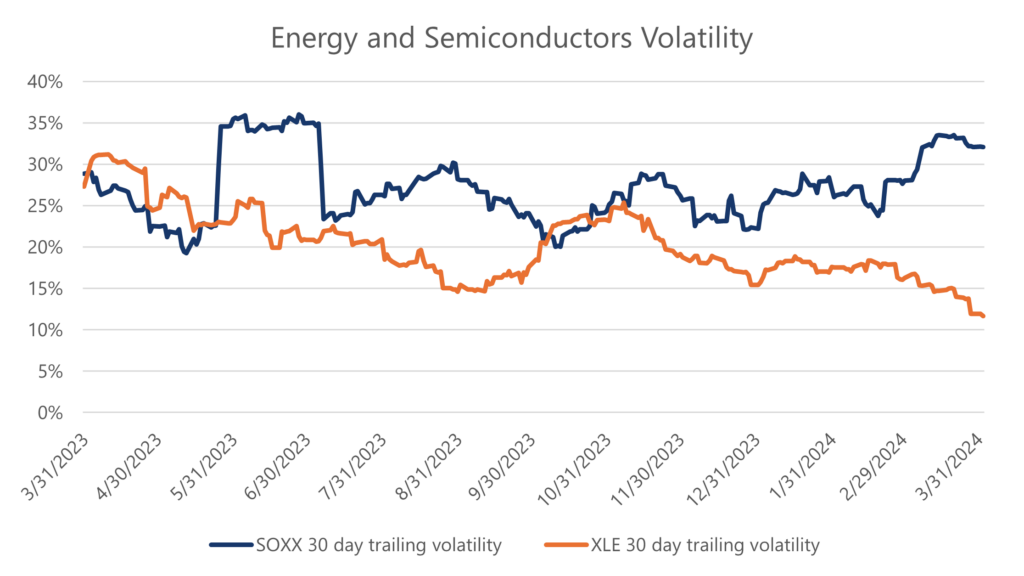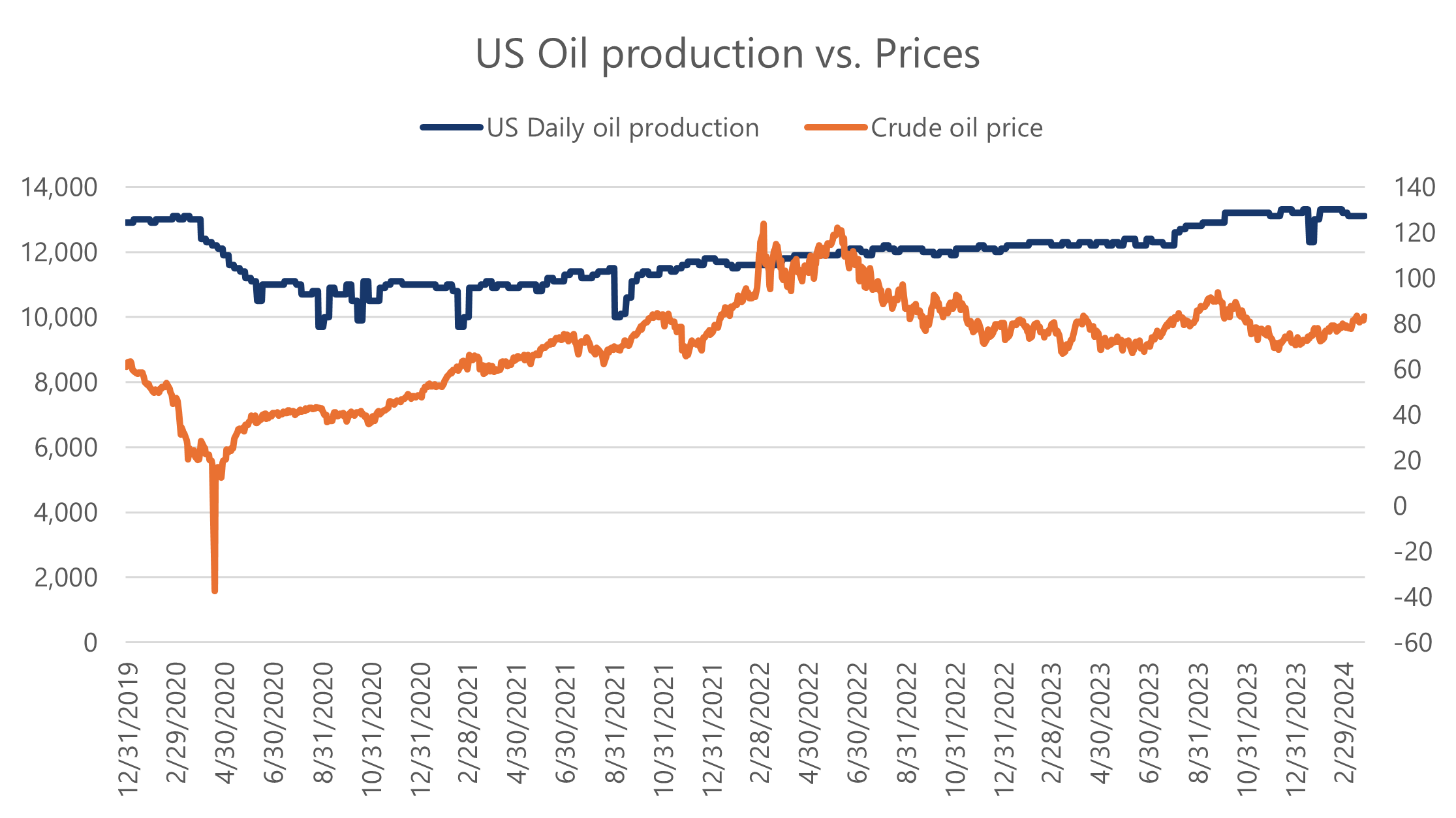A strong quarter for Decathlon, driven by astute ETF selection.
The Decathlon strategies had an excellent quarter with all asset allocation models beating their asset mixture benchmarks (on a net and gross basis). This was achieved despite below neutral equity exposure for most of the quarter. Once again, we held at least one of the top performing Exchange Traded Funds (ETFs) in our investment universe in every strategy. Some of these include Homebuilders, Semiconductors, Mid-Cap Quality, and Energy.
While narrow market leadership has made passive equity markets difficult to outperform over the past quarters, our systems have generally acknowledged this and have gravitated towards the market leading U.S. Technology and Growth sectors. As further evidence of the ranking systems efficacy, our nearly 3-year-old market neutral strategy (Javelin)—which holds 16 of the top ranked equity ETFs and shorts 16 of the worst ranked equity ETFs—achieved a double digit return[1] with approximately 0 equity market beta over the past year.
The investment system has begun to signal potential broadening in the market.
Towards the end of the quarter, we noticed a shift in the system’s rankings away from some of the long-held equities which had been market leaders and into new and seemingly wide-ranging opportunities within equities. This coincided with a noticeable broadening of overall equity markets towards the end of the quarter. Current equity holdings include India, Energy, Cybersecurity, Biotechnology, High-Beta Equities and Retail. The current portfolio (as of 04/01/2024) is our most diversified in recent years, and, we think, a good fit for the current pricey and rapidly evolving environment.
We are optimistic for opportunities in more diverse equities.
We are cautiously constructive on equities given the recent run up and the ongoing strong economic data and corporate performance. The economy appears to be in a virtuous circle, with sharply rising stock prices and stable/rising home prices sustaining confidence among both consumers and CEOs.
Corporate profit margins are exceeding expectations. Starting in late 2022, corporations reduced staff, cut other costs and raised prices where possible, bracing for ongoing inflation and supply chain complications. Inflation has since abated, resulting in very strong profits despite many industries still showing weak sales. Given this backdrop, earnings would necessarily grow given any resumption in revenue growth.
Earnings growth would offer the opportunity for more businesses to participate in the strong equity markets which have thus far been driven predominantly by the largest companies expected to benefit from the advancements in artificial intelligence. These companies have seen their valuations expand precipitously over the last few quarters[2] and have dragged overall equity indices to historically expensive levels.
Inflation might be under control, but risks are lurking.
Inflation appears to be under control despite remaining above the Federal Reserve’s (the Fed) target rate, and expectations for the timing of interest rate relief have been pushed out. As the majority of both core and total inflation now resides in transportation services and shelter, with both categories exhibiting large one-time increases set to roll off at the end of the year, we hope the Fed will move towards a more neutral rate potentially around 3.5% over the intermediate term.
We do worry that if the Fed keeps rates restrictive for too long, we could see a resumption of inflation flowing from a lack of investment from businesses. This could cause another supply pinch and allow inflation to re-emerge. We also believe many commentators have discounted the impact China’s sputtering post-Covid economy may have had on decreasing global inflation. Any re-emergence of economic growth in China might also re-spark inflation as demand from Chinese consumers increases with the country’s economic growth.
Other risks remain unresolved.
- While Investors appear to have acclimated to the higher level of geopolitical tension, the wars in Ukraine and Gaza continue, as well as the Cold “economic war” between the U.S. and China.
- Commercial Real Estate remains the most visible troublesome sector with nothing resolved with respect to high vacancy rates, excess capacity, and declining building values. The sector should get some relief if and when the Federal Reserve lowers interest rates.
- Cryptocurrency speculation returned with great fanfare in the first quarter. The release of Bitcoin ETFs and the prospect of the upcoming “halving[3]” combined with generally accommodative capital markets to drive bitcoin prices to new highs.
- We remain concerned that investor expectations about the immediate transformative impact of AI are too high and some leading suppliers of AI infrastructure appear to be viewed as having long-term monopolistic positions despite many of the world’s largest companies and governments looking to invest in the space. We recently reduced our exposure to semiconductors for the near term, based on the Decathlon trading signal, which fits with our fundamental concerns. Fortunately, there appear to be a variety of near-term investment opportunities elsewhere.
Changing equity exposure in the higher risk profiles.
Typically, we’d expect our models to gravitate towards high percentages of equity in markets like the one we saw over the past two quarters (strong momentum and low volatility). It may have been surprising that both our Moderate and Growth models were consistently near their neutral equity exposures, however, due to a combination of holding high beta and relatively similar securities, we did realize very high market betas—even approaching 100% in the aggressive model. It is possible higher or similar equity exposure but with more diversified equity choices will have the opposite effect, resulting in lower market betas and a more defensive portfolio than may be perceived going forward.


Disclosure: Generated from internal data derived from price data obtained from Bloomberg. Equity percentage is the percentage of holdings identified as “Equity” and may not include real estate and other alternative ETFs that are more equity-like. Average SPY Beta is the average rolling 30-day beta to the State Street S&P 500 ETF for each of the ETFs held in the portfolio.
Characteristics of well-liked securities
The first quarter represented an interesting case study on the type of behavior the Decathlon system gravitates towards. While the combination of variables used in the ranking formulas can identify very subtle patterns, we are able to identify the most important characteristics of well-liked ETFs based on how broadly they are used in the system. High ranked securities tend to represent two types: securities exhibiting lower correlations and strong momentum, or recently beaten down securities with favorable long-term track records that look like near-term opportunities. Another common factor is lower than normal or declining volatility. We saw a major shift in the portfolios during the quarter away from Semiconductors and into Energy. Both are typically volatile sectors, but during semiconductors’ run of strong performance over the past year, the sector was less volatile than it typically is. However, that volatility ticked up towards the end of the quarter coinciding with our sale in the Growth model. Conversely, Energy was never consistently ranked highly in 2022 despite strong performance. We believe this may be due to the sector’s high volatility[4]. With relatively stable but rising energy prices, we saw the Energy sector’s volatility continuously fall to what are now very low levels historically. This coincided with a consensus high ranking across all risk profiles.

Source: Derived from Bloomberg price data from 12/31/2020 – 3/31/2024
Oil
The broad energy sector is a new consensus holding and as such, its prospects are worth examining. Oil prices appear to be backstopped by continued supply restrictions from OPEC, who has feared a global economic slowdown for some time. Meanwhile the world’s largest oil producing country, the United States, continues to take share of Global Oil supply. The “boom and bust” shale cycle that culminated in negative futures prices for crude oil during Covid created an industry that continues to consolidate. With better balance sheets has come better behavior and more consistent economic performance. We believe all of this looks to make energy a less risky sector than it had been in the past with additional potential upside for Oil prices should any of the volatile geopolitical situations escalate or should China, the world’s second largest oil consumer, get its economic act together.

Source: Data sourced from Bloomberg. US Daily oil production and crude oil prices data from 12/31/2019 to 3/31/2024. US Share of global oil production data from 12/31/2012 to 3/31/2024 sourced from Bloomberg
Concluding thoughts
Markets usually top when there is not much to be worried about. Inflation may have been a “straw man” for markets to climb the “wall of worry” since the majority of it proved transitory. Both expectations and sentiment now reflect the prospect of a stronger economy and the potentially massive changes from a wave of AI innovation. While strength often begets strength, the risk for investors is that high expectations must continue to be satisfied.
We are pleased with how the models have navigated the strong markets over the past few quarters and hope the increasing diversification within our portfolios will help us to capitalize in the current environment.
[1] BCM Decathlon Javelin Net Performance: 1Q24 = 4.88%; 1-year = 11.91%; Annualized Since Inception = 5.69%. Inception date is 7/1/2021. Performance data shown represents past performance and is no guarantee of future results. Investment return and principal value will fluctuate, so you may have gain or loss when shares are sold. Strategy performance is through 03/31/2024 and is net of maximum applicable management fee of 0.50%. Current performance may be higher or lower than that quoted. Total returns include changes in share price and reinvestment of dividends and capital gains, if any. Custodial and trading costs will vary by account size and are estimated to be an additional 0.15% depending on which strategy and custodian is used. Estimated trading costs may be higher for smaller accounts due to the minimum transaction fee varying by custodian. Those percentages do not include the expenses of the ETFs held in client accounts, however, an ETF’s expenses are reflected in the ETF’s share price. Performance for periods greater than a year is annualized; if less than a full year, the return is cumulative. The performance shown is for the stated time period only. Differences in account size, timing, management fees, custodian and platform fee structure, price of transactions and market conditions prevailing at the time of investment may lead to different results. Differences in the methodology used to calculate performance may also lead to different performance results than those shown. All returns are expressed in U.S. dollars.
[2] The valuations of some sectors are concerning. In semiconductors, AI darling Nvidia now has a $2.3 Trillion market capitalization, which works out to over $100 million in value for each of its 22,200 employees, which has to be some sort of record. By comparison, Nvidia’s main supplier, manufacturing powerhouse Taiwan Semiconductor, a globally unique company as well, sports a market capitalization of $706 billion, or $9.6 million per 73,000 employees.
[3] On April 20th the “reward” for mining a block of bitcoin will be cut in half. This has the effect of reducing new supply of bitcoin, which is a very small percentage of all outstanding bitcoin at this point, but is often pointed to as a reason for bitcoin to appreciate over time.
[4] In 2022 the Energy sector was the most volatile sector in the entire S&P 500 while being the best performing, a very rare combination.




